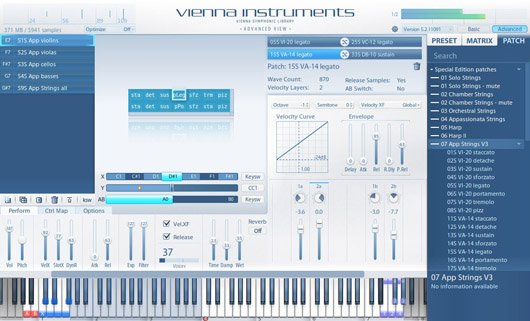Review: Vienna Instruments Special Edition Vol. 1
The pursuit for a reliable means of digitally recreating realistic acoustic sounds has been around […]

The pursuit for a reliable means of digitally recreating realistic acoustic sounds has been around since the inception of digital audio. In 2003, the Austrian cellist/composer Herb Tucmandl completed a massive undertaking to this end, and created the Vienna Symphonic Library (or VSL)—an intensive collection of samples culled over years spent painstakingly recording each possible note and expression of virtually every orchestral instrument available. Upon its release, the VSL quickly became the industry standard for computer-generated orchestral reproduction in professional-grade TV and film studios, and received high praise for its attention to detail and depth of recordings. Since then, Tucmandl’s company has continually made attempts to open this resource to more musicians, finding ways to chip away at the original price tag (even now the VSL Vienna Super Package will still run you well over $6000). The Vienna Instruments Special Edition packages are the company’s latest effort to that end, aimed at getting its technology to home users and studios by enabling access to a truncated version of its library via a VST/AU/RTAS plug-in.
Special Edition Vol. 1 features what the company refers to as the “Essential Orchestra” instruments—including an array of strings, horns, woodwinds, keyboards, and percussion sound sources. The Vienna Instruments software that comes with the package is, for the most part, relatively easy to use, especially after viewing one of the product’s well-made and informative tutorial videos. Fortunately, the software (which can be used both as a plug-in and a stand-alone program) allows for different layers of complexity. This makes it so users can get sounds up and running quickly using the “Basic” view—adjusting simple settings like Reverb and Expression—while still being able to access the more subtle and sophisticated features of the instruments—such as the Velocity Curve, ADSR Envelope, and more—in the “Advanced” view.
The virtual instruments are built using sample components that can be assembled inside of a matrix. Essentially, the different components of an acoustic performance—staccato, legato, portamento, sustain, sforzato, etc.—can be assigned along the matrix and toggled between in order to theoretically yield a realistic performance. This, however, is where things can get a little tricky and where a base knowledge of classical theory seems to be necessary to really understand how to put these matrices together. Still, VSL provides varying ways to approach this. If the user wants to build their instruments from scratch, they can, or they can utilize the fully built factory presets and matrix set-ups as a jumping point. (For a more in-depth explanation of the matrix and other inner workings of the VSL Instruments software, check the video below)
But the real question here is that of sound quality. Considering that this program comes from a classical music background, the instruments sound remarkably clean and crisp. The key- and percussion-based samples sound the most realistic off the bat—the xylophone, celesta, vibraphone, and harp are rewarding from the first touch. Furthermore, the strings, horns, and woodwinds are some of the most realistic sounding samples available on the market at this price point. Still, it should be noted that these sounds are meant to be a baseline from which to create larger and more expansive audio, and while they are exceptionally detailed and nuanced, they are—by design—a bit plain and dry. While this may not be the most inspiring place to start for many producers, it does give plenty of room for molding and shaping the sounds to one’s own taste, which does provide the user with more freedom—albeit at the cost of speed.
In the end, the VSL Special Edition Vol. 1 (there are up to four volumes now) is unarguably a high-quality tool for reproducing acoustic tones. However, it is also a program that requires a good amount of time and attention to detail (particularly in the performance aspect) in order to prodcue the most realistic and satisfying results. Unless one’s production aesthetic relies immensely on recreating distinctly “real”-sounding tones, most home-studio electronic producers would be better off finding a program that loses the immense amount of performance options and does a bit more of the thinking for them.
MSRP: $340

